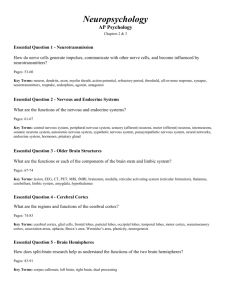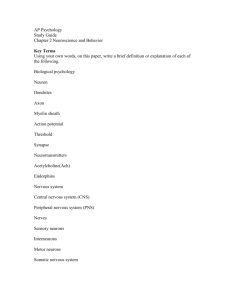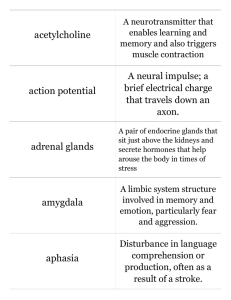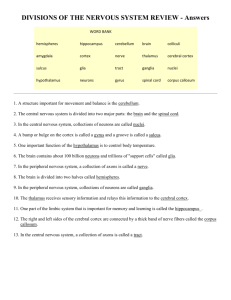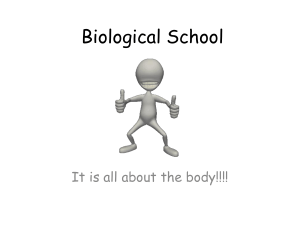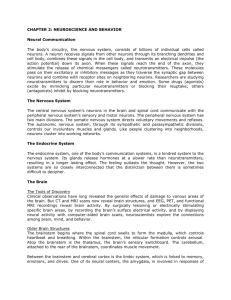Review Outline: Biological Influences
advertisement
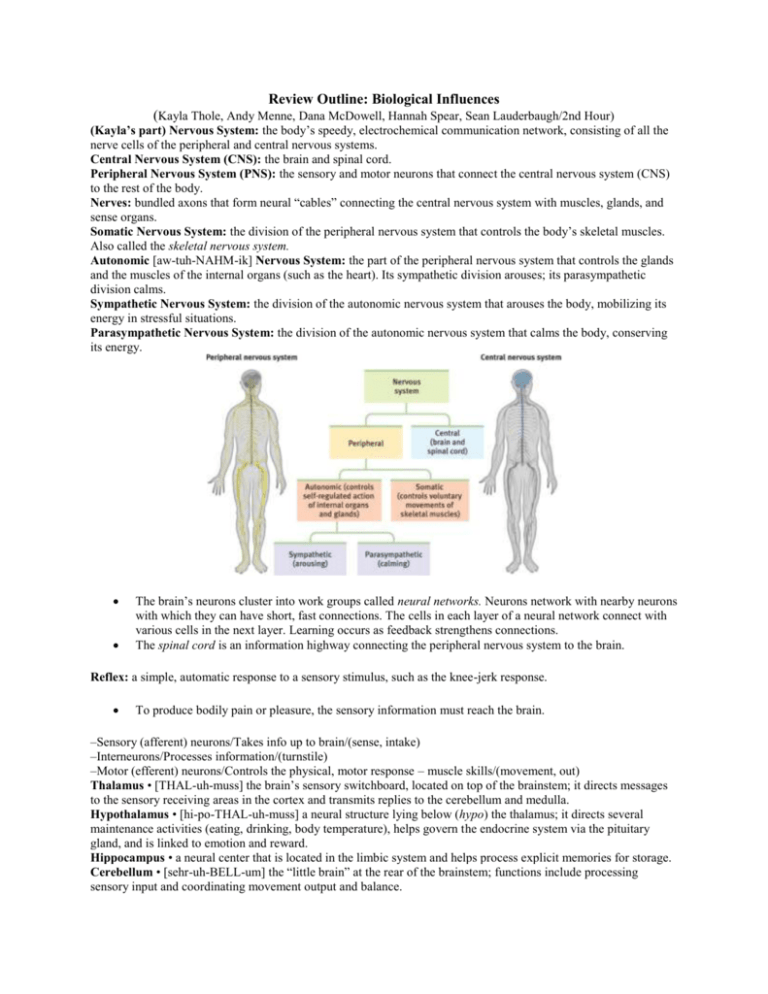
Review Outline: Biological Influences (Kayla Thole, Andy Menne, Dana McDowell, Hannah Spear, Sean Lauderbaugh/2nd Hour) (Kayla’s part) Nervous System: the body’s speedy, electrochemical communication network, consisting of all the nerve cells of the peripheral and central nervous systems. Central Nervous System (CNS): the brain and spinal cord. Peripheral Nervous System (PNS): the sensory and motor neurons that connect the central nervous system (CNS) to the rest of the body. Nerves: bundled axons that form neural “cables” connecting the central nervous system with muscles, glands, and sense organs. Somatic Nervous System: the division of the peripheral nervous system that controls the body’s skeletal muscles. Also called the skeletal nervous system. Autonomic [aw-tuh-NAHM-ik] Nervous System: the part of the peripheral nervous system that controls the glands and the muscles of the internal organs (such as the heart). Its sympathetic division arouses; its parasympathetic division calms. Sympathetic Nervous System: the division of the autonomic nervous system that arouses the body, mobilizing its energy in stressful situations. Parasympathetic Nervous System: the division of the autonomic nervous system that calms the body, conserving its energy. The brain’s neurons cluster into work groups called neural networks. Neurons network with nearby neurons with which they can have short, fast connections. The cells in each layer of a neural network connect with various cells in the next layer. Learning occurs as feedback strengthens connections. The spinal cord is an information highway connecting the peripheral nervous system to the brain. Reflex: a simple, automatic response to a sensory stimulus, such as the knee-jerk response. To produce bodily pain or pleasure, the sensory information must reach the brain. –Sensory (afferent) neurons/Takes info up to brain/(sense, intake) –Interneurons/Processes information/(turnstile) –Motor (efferent) neurons/Controls the physical, motor response – muscle skills/(movement, out) Thalamus • [THAL-uh-muss] the brain’s sensory switchboard, located on top of the brainstem; it directs messages to the sensory receiving areas in the cortex and transmits replies to the cerebellum and medulla. Hypothalamus • [hi-po-THAL-uh-muss] a neural structure lying below (hypo) the thalamus; it directs several maintenance activities (eating, drinking, body temperature), helps govern the endocrine system via the pituitary gland, and is linked to emotion and reward. Hippocampus • a neural center that is located in the limbic system and helps process explicit memories for storage. Cerebellum • [sehr-uh-BELL-um] the “little brain” at the rear of the brainstem; functions include processing sensory input and coordinating movement output and balance. Reticular Formation • a nerve network in the brainstem that plays an important role in controlling arousal. Pons • a part of the brainstem which helps coordinate movements. Medulla • [muh-DUL-uh] the base of the brainstem; controls heart-beat and breathing. Spinal Cord • the cylindrical bundle of nerve fibers and associated tissue that is enclosed in the spine and connects nearly all parts of the body to the brain, with which it forms the central nervous system. Corpus Callosum • [KOR-pus kah-LOW-sum] the large band of neural fibers connecting the two brain hemispheres and carrying messages between them. Cerebral • [seh-REE-bruhl] Cortex the intricate fabric of interconnected neural cells covering the cerebral hemispheres; the body’s ultimate control and information-processing center. Midbrain • the midbrain is a portion of the brain located just above the medulla and pons and contains basic vision and hearing functions; it also is the input center for muscle movement. Amygdala • [uh-MIG-duh-la] two lima bean–sized neural clusters in the limbic system; linked to emotion. Frontal Lobes • portion of the cerebral cortex lying just behind the forehead; involved in speaking and muscle movements and in making plans and judgments. Temporal Lobes • portion of the cerebral cortex lying roughly above the ears; includes the auditory areas, each receiving information primarily from the opposite ear. Occipital • [ahk-SIP-uh-tuhl] Lobes portion of the cerebral cortex lying at the back of the head; includes areas that receive information from the visual fields. Parietal • [puh-RYE-uh-tuhl] Lobes portion of the cerebral cortex lying at the top of the head and toward the rear; receives sensory input for touch and body position. Motor Cortex • an area at the rear of the frontal lobes that controls voluntary movements. Sensory Cortex • area at the front of the parietal lobes that registers and processes body touch and movement sensations. Wernicke’s Area • controls language reception—a brain area involved in language comprehension and expression; usually in the left temporal lobe. Broca’s Area • controls language expression—an area of the frontal lobe, usually in the left hemisphere, that directs the muscle movements involved in speech. Brainstem • the oldest part and central core of the brain, beginning where the spinal cord swells as it enters the skull; the brainstem is responsible for automatic survival functions. Limbic System • neural system (including the hippocampus, amygdala, and hypothalamus) located below the cerebral hemispheres; associated with emotions and drives. Body parts requiring precise control (in the motor cortex) or those that are especially sensitive (in the sensory cortex) occupy the greatest amount of space. Most of the brain’s cortex—the major portion of each of the four lobes—is devoted to uncommitted association areas, which integrate information involved in learning, remembering, thinking, and other higher-level functions. If one hemisphere is damaged early in life, the other will pick up many of its functions.This plasticity diminishes later in life. Some brain areas are capable of neurogenesis (forming new neurons). Split-brain research (experiments on people with a severed corpus callosum) has confirmed that in most people, the left hemisphere is the more verbal, and that the right hemisphere excels in visual perception and the recognition of emotion. (Andy’s part) Basic Biological Processes: neurons- The building blocks of the body, or nerve cells. Sensory neurons- carry messages from the body’s tissues and sensory organs inward to the brain and spinal cord, for processing. motor neurons- Sends information to the body’s tissues. interneurons- Process information in the brain between sensory inputs and motor outputs. dendrite fibers- receive information and conduct it toward the cell body. axon- passes the message along to other neurons or to muscles or glands. myelin sheath- insulates the axons of some neurons and helps speed their impulses. action potential- is a brief electrical charge that travels down its axon. synapse- The meeting point between neurons. neurotransmitters- Chemical messengers.. reuptake- when the sending neuron reabsorbs the excess neurotransmitters. (Andy’s part) Key Contributors in the Biology of Mind: Paul Broca- Is best known for his research on Broca's area, a region of the frontal lobe that has been named after him. The Broca’s area controls language expression- an area of the frontal lobe, usually in the left hemisphere, that directs the muscle movements involved in speech. Carl Wernicke- He researched the Wernicke’s area in the brain, which is an area of the brain that controls language reception- a brain area involved in language comprehension and expression; usually in the left temporal lobe. Charles Darwin- Wrote about a theory of evolution based on natural selection. His work inspired the branch of evolutionary psychology, which is an approach in the social and natural sciences that examines psychological traits such as memory, perception, and language from a modern evolutionary perspective. Michael Gazzaniga- Conducted famous split-brain research and studied cognitive neuroscience. Roger Sperry- won the 1981 Nobel Prize in Medicine for his work with split-brain research. (Dana’s Part) The Influence of Drugs on Neurotransmitters Key Terms: Neurotransmitters: Chemicals located and released in the brain to allow an impulse from one nerve cell to pass to another nerve cell Reuptake: the reabsorption of a neurotransmitter by a neurotransmitter transporter of a pre-synaptic neuron after it has performed its function of transmitting a neural impulse. Stimulants: enhance the activity of the CNS Depressants: slow down or impair the activity of the CNS Hallucinogens: distort the brain’s processing of sensory experiences. Agonists: drugs that mimic the action of a particular neurotransmitter or facilitate the release of the neurotransmitter--thus the presence of the drug enhances the normal effect of the neurotransmitter. Antagonists: block a neurotransmitter functioning. The presence of the agonist causes the neuron to release a larger-than-normal amount of dopamine molecules into the synaptic gap. The presence of the antagonist causes the neuron to release a smaller-than-normal amount of dopamine molecules into the synaptic gap. The Effect of the Endocrine System on Behavior: Endocrine system: a set of seven glands that secrete hormones. These hormones organize our body system and activate behaviors. The thyroid gland, located below the voice box, regulates our metabolism. The metabolism determines how thin people are, and individual alertness and activity level. The parathyroids are located behind the thyroid, and they control levels of excitability. The pineal gland is located in the center of the brain. The pineal gland contains our biological clock and the hormones that regulate sleep-wake cycles. The pancreas is between the small intestine and the stomach. It controls the amount of sugar in the blood stream. Problems with the pancreas cause different types of diabetes. The pituitary gland is located on the underside of the brain; this gland produces a wide range of hormones that control growth rate, sexual behavior, functions surrounding pregnancy, and many other activities. The gonads are located in male testes and female ovaries. These glands help develop individual’s sex characteristics, and male and female orientation. These glands secrete more testosterone in men and more estrogen in women. Both of these hormones have been linked to aggression. The adrenal glands are located just above the kidneys; these are the glands that control the body's reaction to stress. (Hannah’s Part) Electroencephalograph: (EEG) is used for measuring brain activity by placing electrodes on the scalp. It creates a picture of the brain and diagnoses epilepsy, brain tumors, and other neurological conditions. Psychoactive drugs: chemical substances that change behavior, mood, or consciousness. (central nervous system functions) They are used therapeutically to treat physical and psychological disorders. Circadian Rhythm: the name given to the body’s 24 hour time clock. It was discovered by Jean-Jacques d'Ortous de Mairan in the 1700’s because of the movement of plants. Research has decided it is based on an internal sense. Parkinsonism: Postural instability, this neurodegenerative condition impairs motor functions. Also known as Parkinson’s disease. Split Brain Research: William Wagenen. Split brain referred to when the corpus callosum was cut and the two hemispheres were separated. Case Study: An observation technique in which one person is studied in depth in the hope of revealing universal principles. (Sean’s Part) “Nature” -People behave as they do according to genetic predispositions (or "animal instincts"). Nature endows us with inborn abilities and traits. This is the heredity factor of behavior. “Nurture” -People are taught to think and behave in certain ways. Nurture takes these genetic tendencies and molds them as we learn and mature. According to the nurture theory, traits and behavior can be selected for their adaptive value (The degree to which a characteristic helps an organism to survive and reproduce, or affords greater fitness in its environment.) This is the environmental part of behavior. Evolution -The process by which species of organisms come from earlier life forms and undergo change over time through natural selection. Natural Selection -This is the process by which heritable traits that increase an organism’s chances of survival and reproduction are favored than less beneficial traits. -Originally proposed by Charles Darwin, natural selection is the process that results in the evolution of the organism. Evolutionary psychology assumes that human behavior is being shaped by processes of natural selection. Credits Kayla Thole: Describe the nervous system and its subdivisions and functions: -Central and peripheral nervous systems -Major brain regions, lobes, and cortical areas -Brain lateralization and hemispheric specialization Hannah Spear: Historical research and discoveries -Split brain research -psychoactive drugs -EEG’s -Parkinsonism -Circadian Rhythm Andy Menne: - Identified the basic processes and systems in the biological bases of behavior, including parts of the neuron and the processes of transmission of a signal between neurons. - Identified key contributors (e.g. Paul Broca, Charles Darwin, Michael Gazzaniga, Roger Sperry, Carl Wernicke.) Dana McDowell: Discuss the influence of drugs on neurotransmitters. Discuss the effect of the endocrine system on behavior. Sean Lauderbaugh: -Discuss psychology’s abiding interest in how heredity, environment, and evolution work together to shape behavior -Predict how traits and behavior can be selected for their adaptive value


